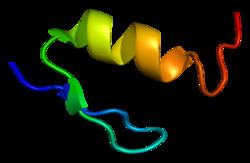Species Human Entrez 7490 | Human Mouse Ensembl ENSG00000184937 | |
 | ||
Aliases WT1, AEWS-GUD, NPHS4, WAGR, WIT-2, WT33, Wilms tumor 1 External IDs MGI: 98968 HomoloGene: 11536 GeneCards: WT1 | ||
Gene music using protein sequence of wt1 wilms tumor 1
Wilms tumor protein is a protein that in humans is encoded by the WT1 gene on chromosome 11p.
Contents
- Gene music using protein sequence of wt1 wilms tumor 1
- Medical vocabulary what does wt1 proteins mean
- Function
- Structure
- Clinical significance
- As a drug target
- Interactions
- RNA editing
- Editing type
- Effects of editing
- References
Medical vocabulary what does wt1 proteins mean
Function
This gene encodes a transcription factor that contains four zinc finger motifs at the C-terminus and a proline / glutamine-rich DNA-binding domain at the N-terminus. It has an essential role in the normal development of the urogenital system, and it is mutated in a subset of patients with Wilms' tumor, the gene's namesake. Multiple transcript variants, resulting from alternative splicing at two coding exons, have been well characterized. There is also evidence for the use of non-AUG (CUG) translation initiation site upstream of, and in-frame with the first AUG, leading to additional isoforms.
Structure
The WT1 gene product shows similarity to the zinc fingers of the mammalian growth regulated early growth response protein 1 (EGR1) and (EGR2) proteins.
Clinical significance
Wilm's tumour tumor suppressor gene1 (WT1) causes an embryonic malignancy of the kidney, affecting around 1 in 10,000 infants. It occurs in both sporadic and hereditary forms. Inactivation of WT1 causes Wilm's tumour, and Denys-Drash syndrome (DDS), leading to nephropathy and genital abnormalities. The WT1 protein has been found to bind a host of cellular factors, e.g. p53, a known tumor suppressor.
WT1 is mutated in a mutually exclusive manner with TET2, IDH1, and IDH2 in acute myeloid leukemia. TET2 can be recruited by WT1 to its target genes and activates WT1-target genes by converting 5mC into 5hmC residues at the genes’ promoters, representing an important feature of a new regulatory WIT pathway linked to the development of AML.
The serine protease HtrA2 binds to WT1 and it cleaves WT1 at multiple sites following the treatment with cytotoxic drugs.
Using immunohistochemistry, WT1 protein can be demonstrated in the cell nuclei of 75% of mesotheliomas and in 93% of ovarian serous carcinomas, as well as in benign mesothelium and fallopian tube epithelium. This allows these tumours to be distinguished from other, similar, cancers, such as adenocarcinoma. Antibodies to the WT1 protein, however, also frequently cross-react with cytoplasmic proteins in a variety of benign and malignant cells, so that only nuclear staining can be considered diagnostic.
As a drug target
WT1 has been ranked by the National Cancer Institute (NCI) as the Number 1 target for cancer immunotherapy.
A vaccine that induces an innate immune response against WT1 is in clinical trials for various cancers.
Interactions
WT1 has been shown to interact with TET2, U2AF2, PAWR, UBE2I and WTAP. In combination with Cited2 activates WT1 the Steroidogenic factor 1
RNA editing
There is some evidence for RNA editing of human WT1 mRNA.As with alternative splicing of the gene RNA editing increases the number of isoforms of this protein.
Editing is tissue specific and developmentally regulated. Editing shown to be restricted in testis and kidney in the rat. Editing of this gene product has been found to occur in mice and rats as well as humans.
Editing type
The editing site is found at nucleotide position 839 found in exon 6 of the gene.It causes a codon change from a Proline codon (CCC) to a Leucine codon (CUC)
The type of editing is a Uridine to Cytidine( U to C) base change .The editing reaction is thought to be an amidation of uridine which converts it to a Cytidine.The relevance of this editing is unknown as is the enzyme responsible for this editing.The region where editing occurs like that of other editing sites e.g. ApoB mRNA editing is conserved.Mice, rat and humans have conserved sequences flanking the editing site consisting of 10 nucleotides before the editing site and four after the site.
Effects of editing
RNA editing results in an alternative amino acid being translated. The changes in amino acid occur in a region identified as a domain involved in transcription activation function.
Editing has been shown to decrease repressive regulation of transcription of growth promoting genes in vitro compared to the non edited protein. Although the physiological role of editing has yet to be determined, suggestions have been made that editing may play a role in the pathogenesis of Wilms tumour.
